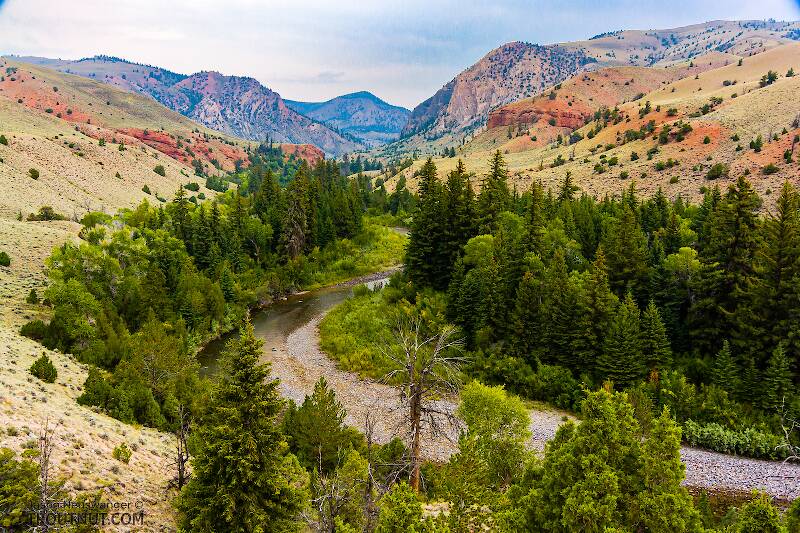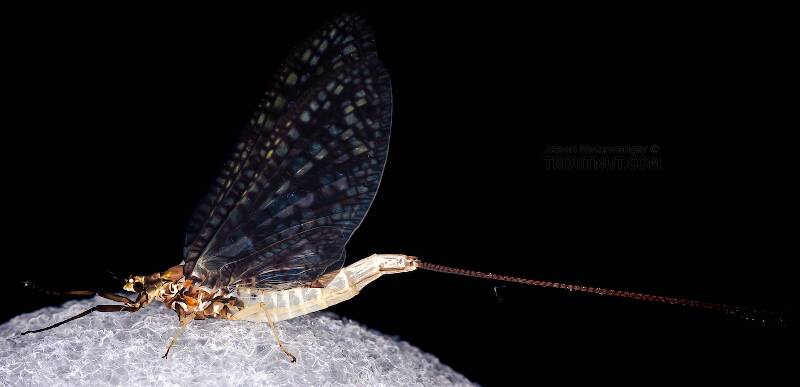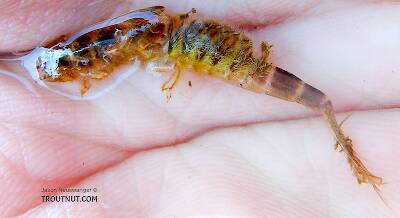
Salmonflies
Pteronarcys californica
The giant Salmonflies of the Western mountains are legendary for their proclivity to elicit consistent dry-fly action and ferocious strikes.


Mayfly Species Ephemera guttulata (Green Drakes)
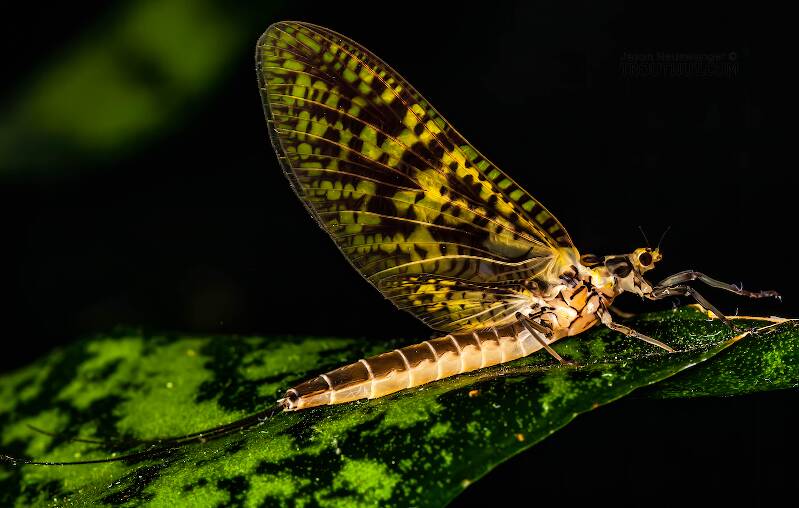
It is on par with the Midwest's Hexagenia limbata hatch for its ability to lure huge piscivorous brown trout to eat insects at the surface once a year. The special charm of the Green Drake hatch is that it often takes place during pleasant spring afternoons. It can be challenging because the large flies are easy for trout to inspect in the daylight and they feed very selectively, especially late in the hatch. The huge difference in appearance between green drake duns and the spinners, white-bodied "coffin flies," makes them a peculiarity among major hatches.
The Green Drakes are on the decline due to environmental degradation.
Where & when
This hatch begins in Pennsylvania in late May and moves into the Catskills through early June. Mid to late June sees Green Drake action in the Adirondacks and other northern New England rivers.In 22 records from GBIF, adults of this species have been collected during June (68%), May (23%), and July (9%).
In 6 records from GBIF, this species has been collected at elevations ranging from 938 to 2161 ft, with an average (median) of 1901 ft.
Species Range
Hatching behavior
"They emerged from their shucks with such speed that I was usually left with an empty shuck and the subimago with which I was already familiar. I began to think that catching the trout was easier than catching the nymphs that the trout were catching."
This haste makes emerger patterns unimportant, but luckily the duns take a long time to get off the water. They flutter around and make several awkward attempts, drawing explosive strikes from trout. Hackled imitations that can be twitched to match this behavior are popular.
Knopp and Cormier write that the best hatches happen during "sustained periods of warm weather."
Spinner behavior
Time of day: Dusk
Just like Ephemera simulans, Ephemera guttulata spinners in the air do not always mean spinners on the water. Subtle shifts in weather may push promising spinner clouds of both species back into the trees for the night. This usually happens when they are still gathering at treetop level. Once the swarms descend and you find yourself surrounded by them, they are almost sure to fall on the water, and good fishing will follow unless the trout have just filled up on nymphs and duns during the hatch.
The spinners are known as "Coffin Flies" and they are black and white. They look like a completely different species than the greenish yellow duns.
Nymph biology
Substrate: Silt and detritus, sometimes fine gravel and sand
Environmental tolerance: Low tolerance for pollution and warm water
Ephemera guttulata Fly Fishing Tips
The mature nymphs of this species are darker than the yellow bodies of other Ephemera nymphs. Ernest Schwiebert described them as "dark greyish-brown."The males are smaller than the females, and both genders vary greatly in size depending on the fertility of the water. You should size your flies based on naturals you collect or on the local fly shops; don't just buy a few from a national outlet and expect them to match your river's hatch.
Physical description
Most physical descriptions on Troutnut are direct or slightly edited quotes from the original scientific sources describing or updating the species, although there may be errors in copying them to this website. Such descriptions aren't always definitive, because species often turn out to be more variable than the original describers observed. In some cases, only a single specimen was described! However, they are useful starting points.
Male Spinner
Wing length: 13.5–15 mm
Abdomen largely creamy white, no black pencilings; contrasted strongly with wings, which appear largely blackish.
Head red-brown; frontal portion of median carina blackish; basal joints of antenna whitish, filament pale red-brown; heavy black rings at bases of ocelli. Pronotum light red-brown, with darker lateral areas; posterior margin whitish at median line. Remainder of thorax very dark red-brown; large pale areas on pleura, anterior to wing roots, at bases of legs, between wing roots and legs. Fore legs dark reddish brown; a white area apically on dorsal edge of coxa; apical half of tibia and all joinings deeper brown; tarsus slightly paler than femur and tibia. Claws marked with whitish. Middle and hind coxae and trochanters red-brown; femora yellowish with faint tinge of red; tibiae and tarsi whitish; apical margin of femur red-brown, claws largely pale purplish brown (Eaton says, blackish spot at apex of tibia, tarsus sometimes light red-brown).
Wing so heavily blotched with dark purplish or blackish brown as to appear largely blackish. Longitudinal veins in anterior half of fore wing dark red-brown, elsewhere yellowish amber. Cross veins blackish or dark red-brown. Majority of cross veins in fore wing widely margined with dark purplish brown, forming many large blotches of same color, arranged much as in Ephemera simulans, but more extensive and with additional dark areas. Bullar stripe may extend to cubital vein; very wide at fork of posterior branch of radial sector, covering 5 to 6 veins within this fork. A partial second stripe on some wings, at first apical blotch beyond bulla; in others, this and next blotch beyond it may be partially fused; several other small blotches near margin of wing, from apex to cubitus; elongate blotches between branches of cubitus; other dark areas larger than in Ephemera simulans, cross veins more widely margined. In hind wing, majority of cross veins rather widely margined, those of anal region only narrowly dark-edged. A large dark blotch near base of subcostal space; another in the two spaces just below it, at basal and second fork of radial sector; below the latter, cross veins very widely margined for three spaces; smaller blotches nearer outer margin, which is widely tinged with pale reddish brown.
Abdominal segments 2-8 wholly pale yellowish white, except for reddish pleural streak on 8; median apical area of tergite 1 also pale, remainder of 1 red-brown; segment 10 largely bright red-brown, two yellow lateral streaks on tergite; lateral reddish-brown stripes on sternite 9, and pleural margin same color. Forceps reddish-brown, second joint paler; third joint relatively longer than in others of this genus. Penes distinct structurally from other species in our fauna (fig. 82). Tails olive to pale reddish brown, joinings blackish brown.
The very pale abdomen, wholly lacking the usual blackish pencilings, combined with the very dark-appearing wings, distinguishes this from other species.
Specimens of the Mayfly Species Ephemera guttulata
1 Female Dun

1 Male Spinner
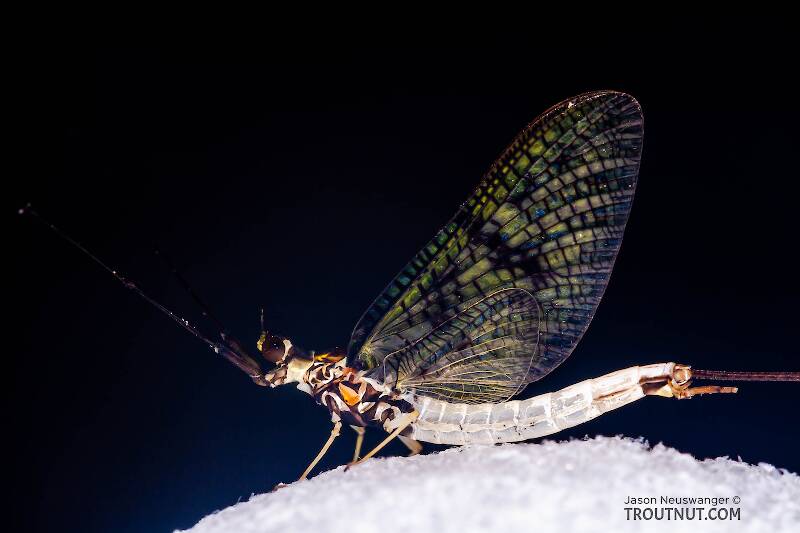
1 Female Spinner
1 Streamside Picture of Ephemera guttulata Mayflies:
Discussions of Ephemera guttulata
My question here is this: does anybody know of streams that have this type of prolonged emergence (2-3 weeks) in NY, PA, MD, or WV?
One individual described it to us that after observing the trout underwater during a Green Drake hatch, many of the strikes pull a small part of the fly (wing, leg) underwater and they swirl and swallow it there. If that is true, then I can rationalize missing more than 18 fish this weekend. If anyone has observed this please post your observations. Normally we do not have such a great contrast in miss to hookup ratio.
Start a Discussion of Ephemera guttulata
References
- Arbona, Fred Jr. 1989. Mayflies, the Angler, and the Trout. Nick Lyons Books.
- Caucci, Al and Nastasi, Bob. 2004. Hatches II. The Lyons Press.
- Fauceglia, Ted. 2005. Mayflies . Stackpole Books.
- Knopp, Malcolm and Robert Cormier. 1997. Mayflies: An Angler's Study of Trout Water Ephemeroptera . The Lyons Press.
- Needham, James G., Jay R. Traver, and Yin-Chi Hsu. 1935. The Biology of Mayflies. Comstock Publishing Company, Inc.
- Schwiebert, Ernest G. 1955. Matching the Hatch. MacMillan Publishing Company.
- Swisher, Doug and Carl Richards. 2000. Selective Trout. The Lyons Press.
Mayfly Species Ephemera guttulata (Green Drakes)
Species Range
Common Names
Resources
- NatureServe
- Integrated Taxonomic Information System
- Global Biodiversity Information Facility
- Described by Pictet (1843)

